| 18 February |
• yesterday • tomorrow |

Tenth of fifteen children; his father was a farmer and merchant, and the boy was named after Saint John Francis Regis. He was raised in a pious family; one brother became a priest, one sister a nun. Studied at the Jesuit Royal College at Grenoble, France. Joined the Congregation of the Mission (Vincentians) in Lyons, France on 6 March 1769, making his final vows in 1771. Ordained in 1773. Professor of moral theology at the Vincentian seminary in Annecy, France. Nicknamed "the walking library" due to his encyclopedic knowledge. Rector of Annecy in 1786. Director of novices in Paris in 1788. Director of the internal seminary at mother-house of the Congregation of the Lazarists in Paris, France. His community was disbanded, and their house destroyed by the French Revolutionists. Missionary to China in 1791. Assigned to Kiang-si in October 1792, the only European in the area; in 28 years of work, he never mastered the language. In 1793 Clet moved to Hou-Kouang in the Hopei Province where he served as superior of an international group of Vincentian missioners scattered over a very large territory; his pastoral area covered 270,000 square miles. In 1811 government anti-Christian persecutions intensified; the missionaries were accused of inciting rebellion, and had to pursue their work while on the run, often hiding in the mountains. On 16 June 1819, with a bounty on his head, Francis was betrayed by a Christian schoolmaster whose behavior the missionary had tried to correct. Force marched hundreds of miles in chains to trial. On 1 January 1820 he was found guilty of deceiving the Chinese people by preaching Christianity. Martyr.
1748 at Grenoble, France
• slowly strangled to death with a rope while tied on a cross on 18 February 1820 at Au-tshung-fu, China
• buried on Red Mountain by local Christians
• re-interred at the Vincentian motherhouse, Paris, France
• relics moved to Saint Lazare church, Paris
1 October 2000 by Pope John Paul II
https://catholicsaints.info/saint-jean-francois-regis-clet/
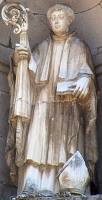
Teotonio
Nephew of the bishop of Coimbra, Portugal. Educated at the University of Coimbra. Parish priest, assigned to Viseu, Portugal. His powerful and outspoken preaching against vice gained him a great reputation, the animosity of the ruling class, and the affection of the king and queen. Counselor to the throne. Rebuked the queen for adultery, and refused a bishopric from her, seeing it as an attempt to buy his affection. He was once asked by the queen to shorten a Mass so she could attend to other business; he send back word that he answered to true sovereigns, and the queen was free to stay or go as she liked.
Theotinus had a great devotion to the poor, and to souls in purgatory. Each Friday he combined these devotions by singing a Solemn Mass for the dead, leading a large procession to the cemetery to pray for the local dead, collecting alms there, and distributing the money to the local poor.
Twice a pilgrim to the Holy Lands. Augustinian Canon Regular, which order he helped bring to Portugal in 1131, entering the monastery at Coimbra. Spent his last 30 years there as monk and prior. Devoted to the daily offices, never allowing the monks to hurry through them. King Alphonsus attributed his victories to the prayers of Theotonius and his brothers, and in gratitude, free all his Mozarabic Christian captives. First Portuguese saints canonized by the modern method.
1086 at Gonfeo, Spain
1166 of natural causes
• 1167 by the Portguese bishops
• cultus confirmed by Pope Benedict XIV
• Coimbra, Portugal, diocese of
• Viseu, Portugal, city of
• Viseu, Portugal, diocese of
His soul will be in Heaven before his body is lowered to the grave. - King Alphonsus, on hearing of the death of Theotonius
https://catholicsaints.info/saint-theotonius-of-coimbra/
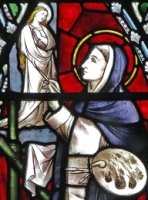
• Angelico of Fiesole
• Beato Angelico
• Fra Giovanni
• Giovanni da Fiesole
• Guido di Pietro
• John of Fiesole
• Painter of the Angels
Joined the Dominicans in Fiesole, Italy in 1407, taking the name Fra Giovanna. He was taught to illuminate missals and manuscripts, and immediately exhibited a natural talent as an artist. Today his works can be seen in the Italian cities Cortona, Fiesole, Florence, and in the Vatican. His dedication to religious art earned him the title Angelico.
1387 in Vicchio di Mugello near Florence, Italy as Guido di Pietro
18 February 1455 in the Dominican convent in Rome, Italy of natural causes
3 October 1982 by Pope John Paul II
artists
Though Fra Angelico completed the cycle of purely supernatural art, he also led the way to that wonderful fusion of the supernatural and the natural in which Italian art culminated a century later. He was the last disciple of Giotto, the first harbinger of Raphael. – Cosmo Monkhouse
To Fra Angelico belongs the glory of fixing, in a series of imperishable visions, the religious ideal of the Middle Ages, just at the moment when it was about to disappear forever. – Georges Lafenestre
https://catholicsaints.info/blessed-fra-angelico/
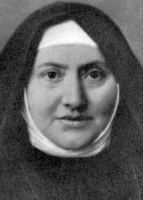
One of a family of eleven children; her father worked an iron forge, and her mother was a seamstress. Caterina joined the Sisters of Charity in Lovere, Bergamo, Italy in 1862, but she became seriously ill and had to return to her family. When recovered, she stayed in lay life, working as a domestic servant for a parish priest in Chiari, Italy, and then for the Countess Fé-Vitali.
In 1878, Caterina made a private vow of chastity, and began teaching children in Capriate San Gervasio, Italy. On 15 December 1882, she founded the Institute of Sisters of the Blessed Sacrament (Sacramentine Sisters); she took the name Sister Gertrude. Her initial plan was that the Sisters would be devoted to Eucharistic adoration; at the recommendation of Pope Leo XIII, they also worked in the world as teachers of young, factory-working women.
18 January 1847 in Biennio, Brescia, Italy as Caterina
18 February 1903 in Bergamo, Italy of natural causes
• 26 April 2009 by Pope Benedict XVI
• her canonization miracle involved the cure of 4 year old Vasco Ricchini of life threatening meningitis in 2001 through the prayers of the Sacramentine Sisters for her intercession
Institute of Sisters of the Blessed Sacrament (Sacramentine Sisters)
https://catholicsaints.info/saint-gertrude-caterina-comensoli/
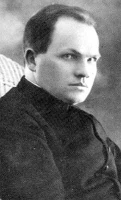
• George Kashira
• George Kaszyra
• Juryj Kašyra
• Giorgio, Jerzy, Yuri
12 June as one of the 108 Martyrs of World War II
Raised in an Orthodox family, George converted to Roman Catholicism in 1922 at age 18. He joined the Marians of the Immaculate Conception in 1924 in Druya, Belarus, and made his profession on 2 August 1929. He studied theology and philosophy in Rome, Italy, then at the seminary of Vilnius, Lithuania. Ordained a priest on 20 June 1935. He taught catechism in Druja, and in the seminary in Vilnius.
In 1938, Polish authorities ordered Father George to end his pastoral work in western Belarus; he moved to the monastery of Rasno in eastern Belarus and continued his work. In 1940, Soviet authorities, in line with their atheist ideology, kicked him out of the monastery; Father George travelled the area of Belarus and Lithuania, staying at assorted monasteries and continuing his work. On 18 February 1943 the occupation Nazis accused him of helping the partisans, and with several other Catholics, he was locked in the basement of a church which was then set on fire, killing them all. Martyr.
4 April 1904 in Aleksandravele, Vilniaus rajonas, Lithuania
burned alive on 18 February 1943 in Rositsa (Rosica), Vitebskaya voblasts', Belarus
13 June 1999 by Pope John Paul II
https://catholicsaints.info/blessed-jerzy-kaszyra/
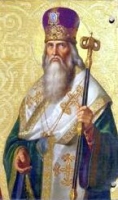
• Father of the Poor
• Taraisius, Tarasio, Tarasios, Tharasius
25 February (Byzantine Rite)
Born to the Byzantine nobility. Consul and then Secretary of State to Emperor Constantine IV and Empress Irene. Though a courtier in the most political of empires, he led the life of a monk. Unanimously chosen Patriarch of Constantinople; Tarasius said that he could not accept such a trust when his see was cut off from full commuion with Rome, which had happened under his predecessor. He convoked a Council on 1 August 786 to settle the dispute of the use of holy images, but Iconoclasts rioted, and the Council was reconvened in 787 in Nicea; the Council determined that the Church was in favour of images, and the Pope approved. Tarasius lived an ascetic life, eating simply and little, sleeping little, reading, praying, working for the Church. When the emperor put away his wife and got a priest to “marry” him to a servant, Tarasius condemned the action and was briefly imprisoned for his defiance.
c.750 at Constantinople
• 25 February 806 of natural causes
• relics preserved in the church of San Zaccaria, Venice, Italy
https://catholicsaints.info/saint-tarasius-of-constantinople/
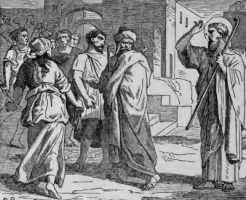
Simeon
A relative of Jesus, possibly a first cousin. He is mentioned in the Gospel of Matthew, and was one of the 72 disciples. He was present at the Ascension, and is one of the brethren of Christ mentioned in Acts who was present at the birth of the Church on the first Pentecost. Reported to have been at the martyrdom of Saint James the Lesser, he was chosen to succeed James as bishop of Jerusalem where he served for over 40 years. In 66, before the city fell to the Romans, the Christians received a divine warning, and evacuated to nearby Pella with Simon as their leader. In the aftermath of the destruction of Jerusalem, Simon led the Christians back to the city where they flourished, performed miracles, and converted many. Simon was eventually arrested, tortured and martyred for the twin crimes of being Jewish and Christian during the persecutions of Trajan.
crucified in 106
https://catholicsaints.info/saint-simon/
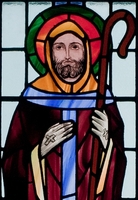
Colman of Mayo
Spiritual student and disciple of Saint Columba. Monk at Iona. Bishop of Lindisfarne, England in 661. Friend of king Oswy of Northumbria. Defended Celtic church practices against Saint Eilfrid and Saint Agilbert at the Synod of Whitby, and when King Oswy insisted on the use of Latin rites, Colman refused, resigned his see, and in 664 led a group of dissident Irish and English monks first to Scotland, then to the Isle of Innishboffin, and then to Mayo, Ireland. Founded the abbey and diocese of Mayo. One of the great heroes of the faith about whom the Venerable Bede wrote.
c.605 at Connaught, Ireland
8 August 676 at Inishboffin abbey of natural causes
dove (his name is a variant of the word for dove)
https://catholicsaints.info/saint-colman-of-lindisfarne/
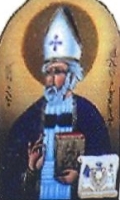
Homer
Raised at the court of Charlemagne, and became his friend and confidante. Studied under Blessed Alcuin. Nicknamed "Homer" because of his Latin poetry. Married to Charlemagne's daughter Bertha. With her permission he turned to religious life when prayers for a successful resistance to a Danish invasion were answered and a storm scattered the Danish fleet; Bertha became a nun. Benedictine monk. Court chaplain, privy councilor, and diplomat. As a reward for his help in court, Charlemagne gave Angilbert the abbey of Saint Riquier in Centula where he served as abbot. He established a library at Centula, and introduced continuous chanting in the abbey using 300 monks and 100 boys in relays. Executor of the emperor's will.
c.740
18 February 814 of natural causes
https://catholicsaints.info/saint-angilbert-of-centula/
29 October as one of the Martyrs of Douai
Son of Thomas and Jane Pibush. Educated at Rheims, France beginning 4 August 1580. Deacon in 1586. Ordained on 14 March 1587. Returned to England as missioner on 14 January 1588. Arrested at Morton-in-Marsh, Gloucester, England in 1593 for the crime of priesthood. Spent a year in Gatehouse prison, Westminster. Returned to Gloucester, he escaped on 19 February 1594; he was captured the next day at Matson. Sent back to Westminster, he was convicted on 1 July 1595 for the treason of Catholic priesthood. He spent over five years in Queen’s Bench prison awaiting execution, ministering to fellow prisoners whenever he could.
at Thirsk, Yorkshire, England
hanged on 18 February 1601 at Saint Thomas's Waterings, Camberwell, England
15 December 1929 by Pope Pius XI
https://catholicsaints.info/blessed-john-pibush/
Sadosh, Sadot, Sadota, Sahdost, Schadost, Schiadustes, Shahdost, Zadok
Deacon in service to Saint Barbasymas in the diocese of Seleucia-Ctesiphon. Attended the Council of Nicaea in 325. After Saint Barbasymas was martyred, Sadoth was chosen the new bishop of Seleucia-Ctesiphon. He and his priests went into hiding, covertly ministering to his flock. The forces of King Shapur returned to Seleucia, and Sadoth was arrested along with 128 of his priests, deacons and nuns. Most were immediately executed, but Sadoth and some companions were imprisoned, repeatedly tortured, and offered relief if they would obey the king and worship the sun; they refused.
beheaded c.342 outside the walls of Seleucia, Mesopotamia
• at the bottom a ladder that reaches into heaven
• with Saint Barbasymas
https://catholicsaints.info/saint-sadoth-of-seleucia/
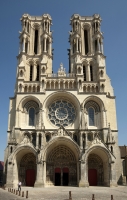
This commemorates the founding of Our Lady of Laon cathedral in Picardy, France by Saint Remigius of Rheims c.500. It was a place noted for miracles, including the image of a bleeding crucifix appearing on the church steeple.
Legend says that when the stone was being hauled to the construction site, one of the loads was so heavy that the oxen could not move it any further; a huge ox suddenly appeared, helped the team move the stone to the site, and then disappeared; 16 of the gargoyles carved on the building are bulls in memory of the work the animals did.
https://catholicsaints.info/our-lady-of-laon/
29 October as one of the Martyrs of Douai
After meeting Saint Edmund Campion, William travelled to Rheims, France were he studied for the priesthood. Ordained in 1592, he returned to England to minister to covert Catholics. Arrested in 1593, he was held for several months before being executed for the crime of being a priest. Martyr.
Felixkirk, Borth Yorkshire, England
hanged, drawn, and quartered on 18 February 1594 at Tyburn, London, England
15 December 1929 by Pope Pius XI
https://catholicsaints.info/blessed-william-harrington/
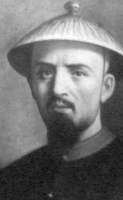
• John Néel
• John Peter Néel
Jesuit priest. Missionary to Kuy-tsheu, China in 1858. Arrested, tortured and martyred with three of his converts.
18 October 1832 in Soleymieux, Sainte-Catherine-sur-Riviere, France
dragged by his hair by a horse, then beheaded at Kuy-tsheu (Kai-chou), China on 18 February 1862
1 October 2000 by Pope John Paul II
https://catholicsaints.info/saint-jean-pierre-neel/
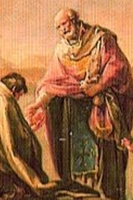
Eladio, Eladius, Elladio, Heladio
Minister in the court of Visigoth kings in Toledo, Spain, his heart was in the nearby abbey of Agali. He eventually resigned his position and became a monk there. Abbot in 605. Archbishop of Toledo in 615.
at Toledo, Spain
632 of natural causes
https://catholicsaints.info/saint-helladius-of-toledo/
• John Zhang Tianshen
• Ruowang
Married layman in the apostolic vicariate of Guizhou, China. Convert. Catechist. Martyr.
c.1805 in Jiashanlong, Kaiyang City, Guizhou, China
beheaded on 18 February 1862 at Kaiyang, Guizhou, China
1 October 2000 by PopeJohn Paul II
https://catholicsaints.info/saint-ioannes-zhang-tianshen/
Mading, Martin
Layman in the apostolic vicariate of Guizhou, China. Convert. Catechist. Martyred for sheltering Blessed John Peter Neel.
c.1817 in Chuchangbo, Qingzhen, Guizhou, China
beheaded on 18 February 1862 at Kaiyang, Guizhou, China
1 October 2000 by PopeJohn Paul II
https://catholicsaints.info/saint-martinus-wu-xuesheng/
• John Chen Xianheng
• Ruowang
Layman in the apostolic vicariate of Guizhou, China. Convert. Catechist. Martyr.
c.1820 in Chengdu, Sichuan, China
beheaded on 18 February 1862 at Kaiyang, Guizhou, China
1 October 2000 by PopeJohn Paul II
https://catholicsaints.info/saint-ioannes-chen-xianheng/
Nun. Sister of Saint Costanzo, bishop of Piedmont, Italy. We know little else about her.
• early 6th century
• relics re-discovered in the 16th century reconstruction of the basilica of Eusebius of Vercelli, interred in the foundations with a placque naming and praising her
https://catholicsaints.info/saint-constance-of-vercelli/
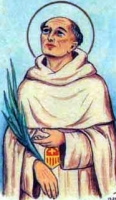
Mercedarian friar assigned to ransom Christians from slavery in Muslim north Africa. Along the way, he preached Christianity until he was seized and murdered. Martyr.
thrown off a mountain
https://catholicsaints.info/blessed-matthew-malaventino/
Nun. Sister of Saint Costanzo, bishop of Piedmont, Italy. We know little else about her.
• early 6th century
• relics re-discovered in the 16th century reconstruction of the basilica of Eusebius of Vercelli, interred in the foundations with a placque naming and praising her
https://catholicsaints.info/saint-esuperia-of-vercelli/
Maenucan, Manchan, Mancheanus, Manchán, Moenagain
Founded a church in Athleague, County Roscommon, Ireland, helping to spread the faith in its early days on the island.
6th century
Athleague, Ireland
https://catholicsaints.info/saint-maonacan-of-athleague/
Martyred for protesting a pagan festival being held near the grave of Saint Paregorius.
260 at Patara, Lycia
https://catholicsaints.info/saint-leo-of-patera/
Eudelme
No information has survived.
Little Sodbury, England
https://catholicsaints.info/saint-ethelina/
Martyr.
260 at Patara, Lycia
https://catholicsaints.info/saint-paregorius-of-patara/
Group of Christians who were martyred together, date unknown. We know nothing else but seven of their names - Classicus, Fructulus, Lucius, Maximus, Rutulus, Secundinus and Silvanus.
African
North Africa
https://catholicsaints.info/martyrs-in-north-africa/
A group of Christians martyred together in the persecutions of Diocletian. We know nothing else but their names - Alexander, Claudius, Cutias, Maximus and Praepedigna.
295 in Rome, Italy
https://catholicsaints.info/martyrs-of-rome-18-february/
CatholicSaints.Info Portable Edition